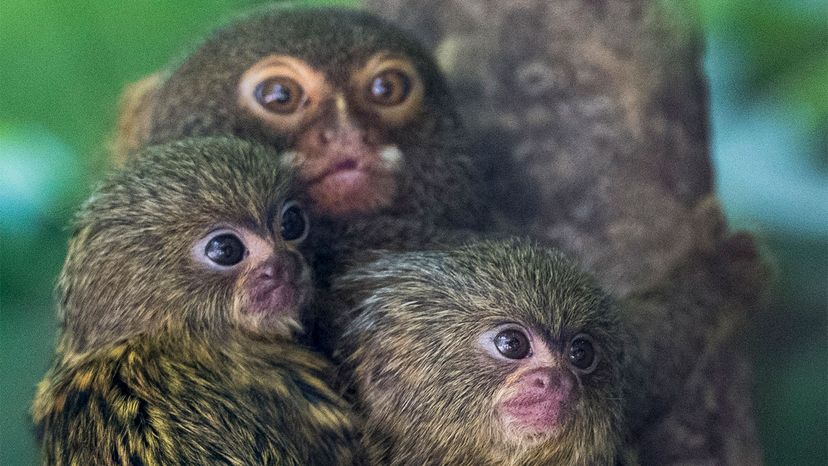
Curious, lively and social, common marmosets are a group of New World monkeys found primarily in the forested areas of central Brazil. There are more than 20 subspecies of marmosets including the pygmy marmoset, the world's smallest monkey which weighs an average of just over 4 ounces (119 grams) and measures just over 5 inches (12 centimeters) in length. Pygmy marmosets are indigenous to Peru, Ecuador, Colombia, Bolivia and Brazil.
Common marmosets are almost exclusively tree-dwellers. Their nostrils are rounded and further apart than Old World monkeys and, though they use their tails for balance, their tails aren't prehensile (they can't grasp with them).
Advertisement
Their tails are banded and long, usually longer than their bodies which are quite small. The average body length for a male marmoset is just over 7 inches (18 centimeters) and they'll weigh about 9 ounces (256 grams); females are just slightly smaller. Their facial skin is pale, but it darkens in the sun. They are covered with fur that flecked with brown, gray and yellow. They have large white ear tufts and a white blaze on their forehead.
Their hands and feet look very similar to a squirrel's, with claw-like nails (tegulae) on all but their big toe, and their thumbs are not opposable. They use these claws to help them move through the trees — quickly, using all four legs like squirrels — but also to scrape and scratch tree bark to get at the gum, sap, and resin that makes up to 70 percent of their diet. Marmosets also forage for insects and also eat fruit, seeds, fungi, nectar and small animals from snails to lizards to nestlings.
They are active for 11 to 12 hours a day and will range only between 0.30 and 0.62 miles (0.5 and 1.0 kilometers). After feeding for an hour after waking, marmosets typically alternate between resting, feeding and socializing with their family group. According to researchers, 53 percent of their time is spent stationary — sprawled out, like a teenager on summer vacation.
But it's not all lolling around the treetops. Being on the small side means marmosets are particularly vulnerable to predators, especially raptors and owls, tree snakes, wild cats and mustelids (weasels, badgers, ferrets and the like). In the wild, the average life span of the common marmosets is 12 years.
We checked in with the Wisconsin National Primate Research Center (WNPRC) at the University of Wisconsin-Madison. The center is home to 314 marmosets who are helping researchers learn more about everything from parenting to Parkinson's disease.
Dr. Marina Emborg is a medical doctor, a professor of medical physics at the University of Wisconsin-Madison, and the director of the Preclinical Parkinson's Research Program at the WNPRC. She says marmosets make excellent subjects in neurological research for several reasons.
"Their shorter life span (16 years in captivity) means they reach adulthood more quickly," she says by email. "They have babies more quickly. Also, when you're studying neurogenerative disease, like me, you need an older subject. A rhesus monkey, for example, isn't 'old' until it's 25 years old, but a marmoset has a shorter life span, so it essentially speeds up the pace of research."
Advertisement



